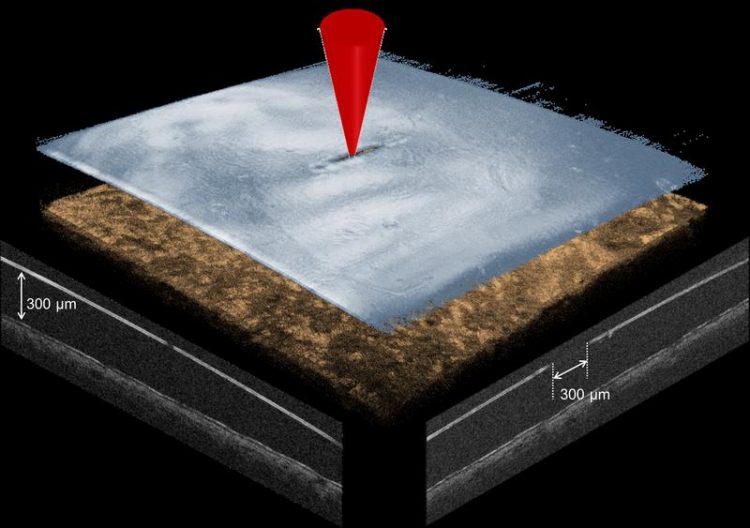Accurate eye operations using lasers and optical coherence tomograph

3-D OCT projection of an fs laser membrane cut (symbolic laser focus in red). The membrane in blue is only 300 µm from the prepared porcine retina in brown. Illustration: LZH
In the established femtosecond laser-assisted in situ keratomileusis (fs LASIK), the cornea is cut open using the laser to subsequently correct the defective vision. In order to treat presbyopia however, the tissue has to be cut deeper.
The scientists at the LZH and their industrial partners use an fs laser for precisely cutting the lens, creating slip planes and thus making the lens more flexible.
Cutting the eye lens with the laser, without damage
This treatment becomes only possible through an effective visualization of the eye tissue. For this, the Image Guided Laser Surgery Group of the Biomedical Optics Department of the LZH has adapted an OCT imaging unit from the ROWIAK GmbH.
With this and a special software it is possible to image the cutting of the eye as well as the laser beam delivery during the operation. Within the project cuts into the eye have already been done without damaging neither the front nor the rear part of the lens capsule. In current clinical studies, the ROWIAK GmbH is further examining this process.
Removing retina adhesions, without opening the eye
In order to remove retina adhesions, currently the eye must be opened and the vitreous body removed. The scientists at the LZH have integrated adaptive optics into an fs laser system, to be able to cut close to the retina.
First results have already been established on the retina of pig eyes: with this system, model membranes only a few hundred micrometers away from the retina have been cut; the retina tissue directly behind it showed no noticeable damage.
In the project “Innovative cataract, presbyopia and retinal treatment using ultrashort laser pulses” (IKARUS), the following partners apart from the LZH and the ROWIAK GmbH (Hannover) as the system manufacturer have been involved: QIOPTIQ Photonics GmbH & Co. KG (Göttingen) as optics designers, ARGES GmbH (Wackersdorf) for laser scanner systems, and the Laserforum Köln e.V. (Cologne) for clinical consulting and for measuring of the eyes. IKARUS was supported by the German Federal Ministry of Education and Research (BMBF) within the research alliance “Ultrakurzpulslaser”.
Media Contact
More Information:
http://www.lzh.de/All latest news from the category: Health and Medicine
This subject area encompasses research and studies in the field of human medicine.
Among the wide-ranging list of topics covered here are anesthesiology, anatomy, surgery, human genetics, hygiene and environmental medicine, internal medicine, neurology, pharmacology, physiology, urology and dental medicine.
Newest articles

Superradiant atoms could push the boundaries of how precisely time can be measured
Superradiant atoms can help us measure time more precisely than ever. In a new study, researchers from the University of Copenhagen present a new method for measuring the time interval,…

Ion thermoelectric conversion devices for near room temperature
The electrode sheet of the thermoelectric device consists of ionic hydrogel, which is sandwiched between the electrodes to form, and the Prussian blue on the electrode undergoes a redox reaction…

Zap Energy achieves 37-million-degree temperatures in a compact device
New publication reports record electron temperatures for a small-scale, sheared-flow-stabilized Z-pinch fusion device. In the nine decades since humans first produced fusion reactions, only a few fusion technologies have demonstrated…





















